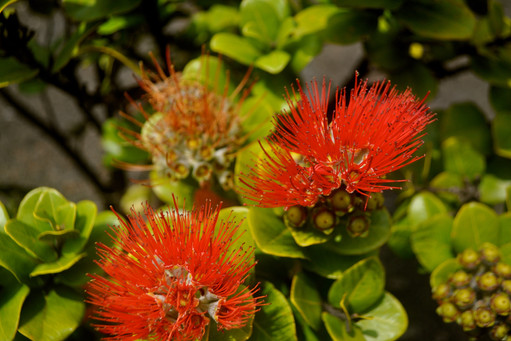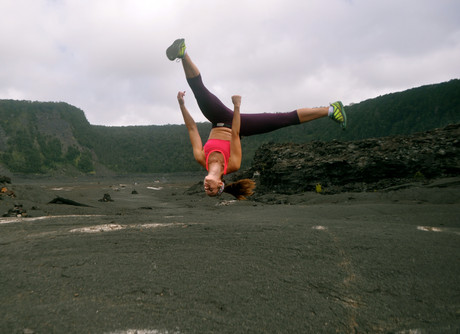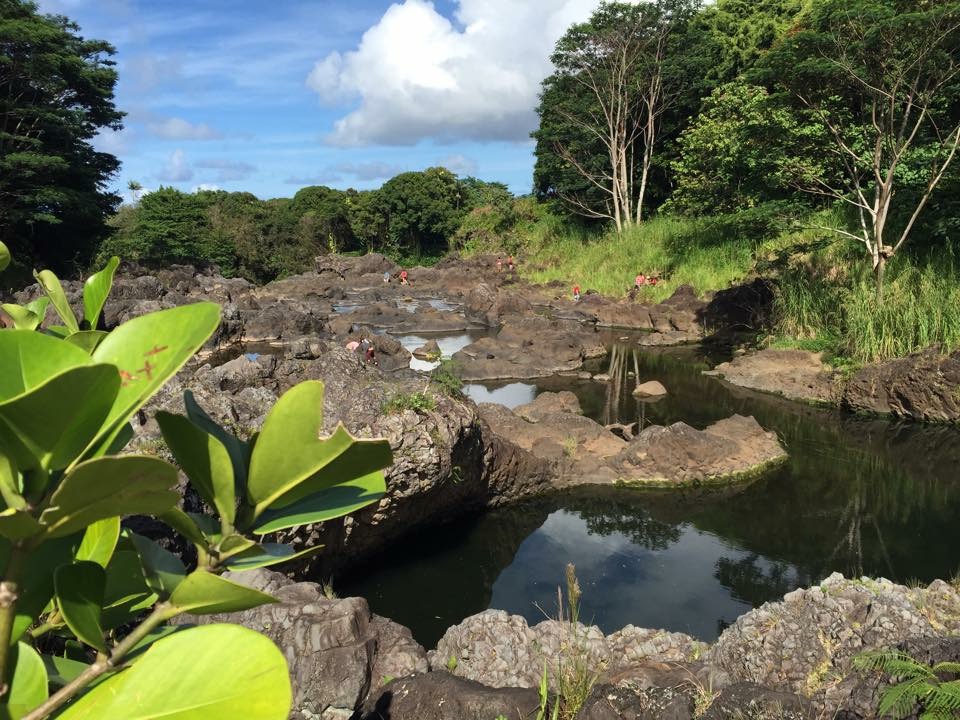Visiting the Kilauea Volcano Eruption
- katiesoltas
- Jul 7, 2018
- 8 min read
Updated: Sep 9, 2018
Local Devastation, New Beginnings and Your Family's Big Island Trip of a Lifetime

My Personal Connection to Kilauea
There’s no denying that Madame Pele, Goddess of Hawai‘i’s volcanoes, is one of the most powerful forces on our planet. She has recently been extremely active in Kilauea within a nearly three-month record-breaking eruption in the Big Island’s Lower East Rift Zone, causing devastation and swallowing over 700 homes and counting in the Puna community since May 3 with no signs of stopping soon. Beautiful neighborhoods, tide pools and beaches have now succumbed to Pele’s wrath, becoming fresh lava fissures pouring into the ocean. The landscape has changed dramatically just in a few months - an eerily different place than the Island I lived on several years ago. Gone are Kapoho Bay and its beloved tide pools, Ahalanui warm ponds, the Vacationland area and much of Leilani Estates.

I lived on the Big Island for 1.5 years and worked as the PR manager at Sheraton Kona Resort & Spa at Keauhou Bay. When my (then) fiancée visited from Oahu, we would frequently drive the 2.5 hours to Hawai‘i Volcanoes National Park (HVNP) to view the lava “glow” that could be seen at night from Jagger Museum and the lava lake in Halema‘uma‘u Crater that rose in 2014, coinciding with the fissures that opened a lava flow that nearly devastated the town of Pahoa. We loved hiking the four-mile Kilauea Iki Crater trail into the pit crater and biking around all areas of the park, from Hilina Pali Road down to Chain of Craters Drive (now closed to the public as an alternate evacuation route).
We stayed at the Kilauea Military Lodge to do all of these activities, which, when open, is accessible to all DoD military, civilian and retired employees. This section of the park, along with the historic Volcano House lodge and restaurant, is closed due to the current eruption. When Volcano House is open, guests can sip a craft cocktail and look out over an active volcano.

Unfortunately, I haven’t been able to witness the current flow in-person, but I have closely followed Pele’s path through interaction with Hawai‘i friends who have access as media or those whose families have personally lost a home. Through the ashes of destruction, new growth will continue to flourish as part of nature’s cycle. New land is being created every day, and soon new tide pools and lagoons will be renewed with ocean life.

Despite how dangerous the international media have portrayed Kilauea’s flow, it is completely safe to visit Big Island. The local economy depends on tourism and has suffered from inaccurate news reports. In fact, the active eruption covers less than one percent of the Island. When you do visit, you’ll likely want to get as up close and personal as possible with Pele (while remaining safe, of course)! Here are some of the best ways to explore the national park and the slopes of Mauna Loa and Kilauea volcanoes during this once-in-a-lifetime opportunity to see a major eruption.
Planning Your Volcano Experience
To ensure there are no surprises during your Big Island adventure, check the HVNP website for updates. As of this post’s publish date on Aug. 17, the majority of the park is closed due to effects of the eruption such as earthquakes, volcanic ash and continuing explosions from Halema‘uma‘u Crater.
However, there are still many ways to enjoy the park, learn about the history of Hawai‘i’s volcanoes and view lava from as close as 250 feet! One venue currently open to the public is the park’s Kahuku Unit in Ka‘u, located an hour south of the national park off Highway 11. If your family is seeking an outdoor experience to experience an active volcano landscape, Kahuku is the clear choice. Open Wednesday through Sunday from 9 a.m. to 3 p.m., Kahuku Unit offers complimentary guided hikes, Hawaiian cultural workshops and other programs on slopes of (also active) Mauna Loa Volcano.
If weather conditions aren’t favorable or you’d like to complement the outdoor experience with more information, HVNP rangers additionally offer educational programs at Mokupāpapa Discovery Center in downtown Hilo on Tuesday through Saturday from 9 a.m. to 4 p.m. and in Volcano village at the Volcano Art Center’s Niaulani Campus from 9 a.m. to 4 p.m. on most days. These venues provide different, alternative programs as well. At Mokupāpapa on Hilo’s gorgeous bayfront, guests can also learn about Papahānaumokuākea Marine National Monument that surrounds the Northwestern Hawaiian Islands, a remote area with visitation limited mostly to park rangers, marine biologists and other government employees. If art and culture pique your interest, the Volcano Art Center and surrounding village will surely deliver.
Lava can be seen (legally) from the air via helicopter tour, by boat and on guided hikes. In general, the helicopter tours are the most expensive for families, but also the safest option. During my tenure at the resort, we frequently worked with Paradise Helicopters and also recommended the slightly larger company, Blue Hawaiian. Note: while I was pregnant, helicopter tours were the only available way for me to see lava. Boat tours and hikes would not allow me to participate.
If you’ve read the news lately, you might have heard about the boat that was hit in late July by a two-foot boulder lava bomb and left 23 passengers injured after getting too close to the lava. Since this incident, U.S. Coast Guard and state officials have been much stricter about the 250-foot lava viewing laws in the sea. The company responsible was Lava Ocean Tours, which has had a relatively clear track record since its founding in 2006 up until last month. Other recommended companies include Hawaiian Lava Boat Tours and Kalapana Lava Boat Tours.
Family-owned-and-operated Hawaii Forest and Trail has a terrific selection of guided hikes and van tours to experience volcanoes in restricted and unknown areas to most visitors. For seasoned hikers pursuing a bit more of a thrill (and a workout), Epic Lava Tours is a reputable company that offers adrenaline junkies the closest encounter with lava by foot. Where to Stay, Dine and Play
I recommend flying into Hilo International Airport for a true volcano trip, unless you are spending time on the Kona side (western side) of Big Island. Unlike Kailua-Kona and the Kohala Coast, Hilo side isn’t known for its full-service and five-star resorts. Fortunately for visitors, the options for decent places to stay are increasing thanks to several renovations, Airbnb and private inns that provide a unique hospitality experience.
Volcano Village
As mentioned, the two lodging options in HVNP are currently closed. If you’d like to stay closer to the volcanic action yet outside of the park, historic Kilauea Lodge in Volcano Village, built as a YMCA camp in 1938, is the perfect venue – with an amazing Sunday brunch to boot at its restaurant. The lodge is walking distance to Volcano Village restaurants and shops.
There is an increasing variety of restaurants in the heart of Volcano Village. My favorite lunch/dinner spot is Ōhelo Café for a locally sourced Hawaiian fusion meal, along with delicious Thai Thai. For Sunday brunch, don’t miss the three-tiered French toast at Kilauea Lodge made with a mix of sweet and taro bread. Just outside of Volcano Village, wine enthusiasts will enjoy the novelty of Volcano Winery with a variety of wines, honey and macadamia nut meade and teas infused with Hawaiian botanicals.
Volcano Village is an art lover’s dream with a bohemian feel...in a natural rainforest. With the Volcano Art Center, several art galleries (with affordable art compared to the Kona-Kohala coast, in my opinion) and a traditional Hawaiian quilt and gift shop, Kilauea Kreations, there’s something for every art enthusiast to appreciate. Tip: avoid downing multiple mimosas at Kilauea Lodge and then going quilt shopping! I may or may not have majorly splurged on a beautiful queen-size quilt and pillows.
Hilo

A stay along Banyan drive in Hilo will evokes 1970’s vibes on the Big Island. Hotels in this location boast excellent views of Hilo Bay and Mauna Kea extinct volcano (which often has a novel snowcapped tip visible from Hilo’s black sand beach), as well as walkability to Hilo town, where guests can visit numerous art galleries, authentic mom-and-pop shops and the 25-acre Japanese garden, Lili‘uokalani Teahouse & Gardens, which pays tribute to Hawai‘i’s last reigning monarch, Queen Lili‘uokalani. Castle Resorts recently overhauled its bayfront Hilo Hawaiian Hotel and Hilton has restored a retro resort to its former glory as the new Grand Naniloa Hotel Hilo. For a more secluded stay complete with a private waterfall, visit the Inn at Kulaniapia Falls. Hilo is about a 45-minute drive to HVNP.

You will find a cultural melting pot of cuisine in Hilo. My personal favorites are Surf Break Café for breakfast/lunch, uber-local Café 100 for lunch – home of the loco moco – and Café Pesto for Italian food and ambiance across from Hilo Bay.
For those who like to explore new destinations by running, Hilo’s Bayfront atmosphere (and typically cooler weather than Kona) makes it a true gem for runners. For flat terrain with an ocean view, venture from Banyan Drive along the bay and back. For more advanced runners, set out on an eight-mile out-and-back from Banyan Drive to Honoli'i Beach Park for steep hills and panoramic views of the ocean and surfers. The Hilo International Marathon is held each March and follows this route.
A short drive up mauka (up the mountain) from Hilo Bay will take you to Rainbow Falls and Boiling Pots above the waterfall. Continue north up Highway 19 toward Honomu, and you will see a sign for Akaka Falls, another wonder of Big Island's East Side.
There are several art galleries in Hilo, but I’ve found Banyan Art Gallery to be the most affordable with equally valued pieces. If you’re looking for nice Hawaiian jewelry to take home, this venue also sells rare Ni‘ihau shell necklaces and earrings, which were worn similarly to gold by Hawaiian royalty and now are the only shells in the world that may be insured. Expect to spend about $100 on a basic Ni‘ihau piece to $700 for a multiple necklace strand. They range from a pinkish red to pure white in color.
Other East Big Island Hospitality and Attractions
Other convenient locations to act as a home base during a trip to see Hawai‘i volcanoes include Pahala, a quiet community on the southeastern side of Big Island, Mountain View, a small village in the volcanic rainforests between Pahala and Hilo and Pahoa, a town much closer to the Lower East Rift Zone near the eastern tip of Big Island. Vacation rentals and small plantation resorts are plentiful in these areas, most available for booking on Airbnb or VRBO. Be sure to check the map to confirm the rental is NOT in the way of a current flow or predicted path of one of the fissures.
To see the glow from the recent eruption while you dine (depending on the current conditions), visit Kaleo’s in Pahoa for live music and an innovative Hawaiian-inspired dinner with an intimate ambiance. It’s about 45 minutes southeast of Hilo and absolutely worth the drive.
If you do visit the Kahuku Unit in Ka‘u, stop by the Ka'u Coffee Mill in Pahala. Produced in rich volcanic soil, many coffee snobs including myself prefer the up-and-coming Ka'u coffee to the wildly popular Kona Coffee. Each fall, the mill hosts a trail run series where participants have the rare opportunity to run through the coffee plantation hills. Stay for the silent art auction that benefits local farmers!

Slightly South of Pahala, you will encounter the picturesque Punalu‘u black sand beach. Visit the Punalu‘u Bake Shop for malasada treats and sweet bread in the southeastern village of Na‘alehu before turning around to head back for the evening.

Keiki-friendly Vacation Scale
Big Island’s Hilo side has plenty of activities for families, especially kids about eight years and up who enjoy science and outdoor adventure. To manage expectations, a relaxing family beach vacation is better suited for the Kona-Kohala side of Big Island. Please don’t hesitate to reach out to katie@fittravelingmama.com with any questions regarding family-specific recommendations (or other feedback).





























Comments